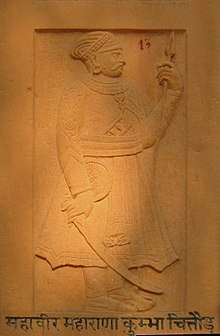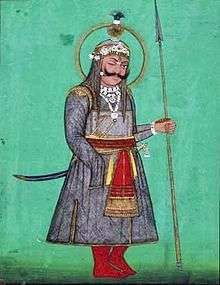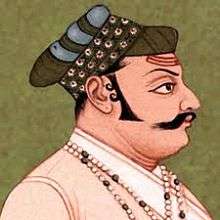Rajput resistance to Muslim conquests
Before the Muslim conquests in the Indian subcontinent, much of northern and western India was being ruled by Rajput dynasties. The Rajput kingdoms contended with the rising and expansionist empires of the Muslim world, be they Arabs, Turks, Pashtuns, or Mughals. The Rajputs held out against the Caliphates and Central Asian empires for several centuries. A few of the Rajput kings converted to Islam, some formed alliance with the Mughals, which laid the foundations for the creation of the multi-ethnic Mughal Dynasty.
|
|
|
Arabs in 8th century
Under the Umayyad Caliphs the Arabs attempted to conquer the frontier kingdoms of India; Kabul, Zabul, and Sindh, but were repulsed. In the early 8th Century the Kingdom of Sindh under Brahman King Dahir of the Rai dynasty was convulsed by internal strife——taking advantage of the conditions the Arabs renewed their assaults and finally occupied it under Muhammad bin Qasim, the nephew of Al-Hajjaj (governor of Iraq and Khurasan). Qasim and his successors attempted to expand from Sindh into Punjab and other regions but were badly defeated by Lalitaditya of Kashmir and Yashovarman of Kannauj. Even their position in Sindh was unstable at this time. Junaid ibn Abdur-Rahman al-Marri, the successor of Muhammad bin Qasim, finally subdued the Hindu resistance within Sindh. Taking advantage of the conditions in Western India, which at that time was covered with several small states, Junaid led a large army into the region in early 730 CE. Dividing this force into two he plundered several cities in southern Rajasthan, western Malwa, and Gujarat.[2]
Indian inscriptions confirm this invasion but record the Arab success only against the smaller states in Gujarat. They also record the defeat of the Arabs at two places. The southern army moving south into Gujarat was defeated at Navsari by the south Indian Emperor Vikramaditya II of the Chalukya dynasty who sent his general Pulakesi to defeat the Arabs.[3] The army that went east, reached Avanti whose ruler Gurjara Pratihara[4] Nagabhatta utterly defeated the invaders who fled to save their lives. Arab forces failed to make any substantial gains in India and in the Caliphate campaigns in India (730 CE), their army was severely defeated by the Indian kings. Bappa Rawal of Mewar defeated the Arabs forming an alliance with the Bhel tribe; as a result, Arabs' territory got restricted to Sindh in modern Pakistan.[2]
Ghaznavid invasions
In the early 11th century, Mahmud of Ghazni conquered the Rajput Hindu Shahi kingdom in the North-west frontier in Afghanistan and Pakistan, and his raids into northern India weakened the Pratihara kingdom, which was drastically reduced in size and came under the control of the Chandelas. Mahmud sacked some temples across northern India to stop idol worship, including the temple at Somnath in Gujarat,[5] but his permanent conquests were limited to the Punjab. The early 11th century also saw the reign of the polymath king Raja Bhoj, the Paramara ruler of Malwa.[2]
Spread of the Gahadvalas, Chandels, Tomars, and Chauhans
The Rajputs occasionally united against foreign invaders – once under Bappa Rawal, then under Shakti Kumar of Mewar and Jaypal Tomar. Once the foreign invasions stopped, the Rajputs fought each other in the eleventh and twelfth centuries.
Major wars broke out between the Tomars of Delhi and Gahadvalas of Kannauj. The Rathores, as the Gahadvala dynasty, established the kingdom of Kannauj, capturing it from Tomar rulers in the 11th century. The Rever dynasty established the kingdom of Tarangadh in 11th through the 12th century, and conquered Marwar in the 13th century. The Chandelas established Jejakbhukti and ruled from Mahoba.[2]
Chauhans established rule over Delhi and Ajmer in the 10th century. The most popular ruler of this dynasty was Prithviraj Chauhan.
Muhammad Ghori was the Muslim king from Afghanistan. He wasn't aware of the power of the Chauhans. During the First Battle of Tarain, Ghori was defeated with heavy losses. However, the Second Battle of Tarain was won by Ghori because of betrayal from Jai Chand as there was enmity between him and Prithviraj.[2]
Delhi Sultanate

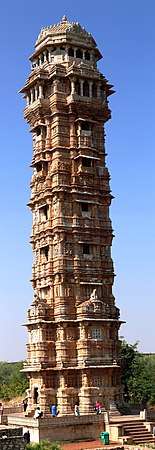
The Delhi Sultanate was founded by Qutb ud din Aybak, Muhammad of Ghor's successor, in the first decade of the 13th century. The Chauhans reestablished themselves at Ranthambore, led by Govinda Chauhan, grandson of Prithviraj III. Jalore was ruled by another branch of Chauhans, the Songaras. Another branch of the Chauhans, the Hadas, established a kingdom in Hadoti in the mid-13th century.[2]
Fight against Khiljis
Sultan Ala ud din Khilji (1296–1316) conquered Gujarat (1297) and Malwa (1305), captured the fort of Mandu and handed it over to the Songara Chouhans. They captured the fortresses of Ranthambore (1301), Mewar's capital at Chittorgarh (1303), and Jalor (1311), after long sieges with fierce resistance from their Rajput defenders. Ala ud din Khilji also fought the Bhatti Rajputs of Jaisalmer and occupied the Golden Fort. He managed to capture three Rajput forts of Chitor, Ranthambore and Jaisalmer, but couldn't hold them for long.[6]
Fight against Tuglaqs
The Mewar reestablished their supremacy within 50 years of the sack of Chittorgarh, under Rana Hammir. In 1336, Hammir defeated Muhammad Tughlaq in the Battle of Singoli[7] with Hindu Charans as his main allies, and captured him. Tughlaq had to pay a huge ransom and relinquish all of Mewar's lands. After this the Delhi Sultanate did not attack Chittorgarh for a few hundred years. The Rajputs reestablished their independence, and Rajput states were established as far east as Bengal and north into the Punjab. The Tomaras established themselves at Gwalior, and the ruler Man Singh Tomar built the fortress which still stands there. Mewar emerged as the leading Rajput state, and Rana Kumbha expanded his kingdom at the expense of the sultanates of Malwa and Gujarat.[2]
 Built during the course of the 15th century by Rana Kumbha, the walls of the fort of Kumbhalgarh extend over 38 km, claimed to be the second-longest continuous wall after the Great Wall of China.
Built during the course of the 15th century by Rana Kumbha, the walls of the fort of Kumbhalgarh extend over 38 km, claimed to be the second-longest continuous wall after the Great Wall of China.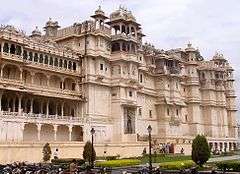 City Palace was constructed by Maharana Udai Singh II after shifting his capital to Udaipur due to Muslim invasion.
City Palace was constructed by Maharana Udai Singh II after shifting his capital to Udaipur due to Muslim invasion..jpg) Amer Fort and Jaigarh Fort are connected by subterranean passages, and are known for their artistic Hindu Rajput style elements.
Amer Fort and Jaigarh Fort are connected by subterranean passages, and are known for their artistic Hindu Rajput style elements.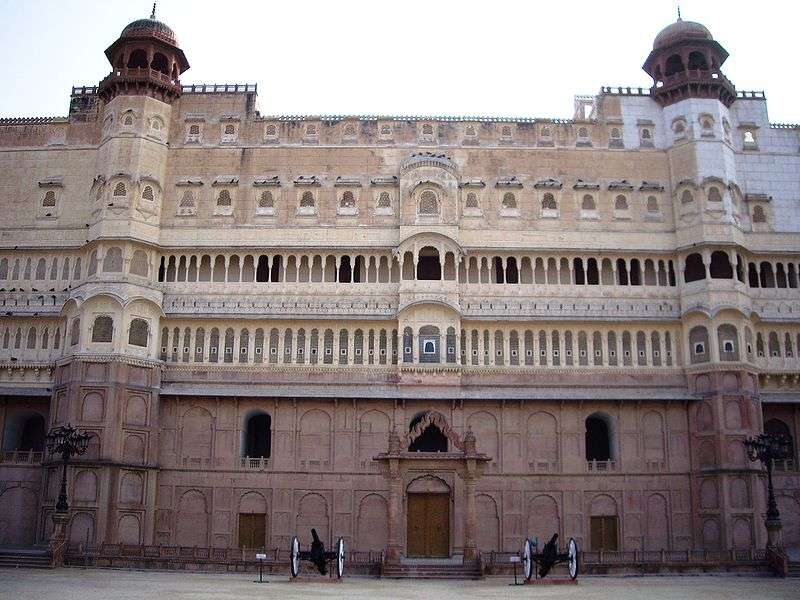 Entrance eastern façade of the Junagarh Fort. Historical records reveal that despite the repeated attacks by enemies to capture the fort, it was not taken, except for a lone one-day occupation by Mughal prince Kamran Mirza.
Entrance eastern façade of the Junagarh Fort. Historical records reveal that despite the repeated attacks by enemies to capture the fort, it was not taken, except for a lone one-day occupation by Mughal prince Kamran Mirza.
Against Lodis
Rajputs under Rana Sanga managed to defend their confederation against Sultanates of Malwa, Gujarat and also Ibrahim Lodi, Sultan of Delhi. Rana Sanga defeated Ibrahim Lodi in two major battles at Khatoli and Dholpur. Soon Mughals under Babur invaded Delhi and defeated Ibrahim Lodi at the First Battle of Panipat on 21 April 1526. Rana Sanga rallied a Rajput army to challenge Babur. Babur defeated the Rajputs at the Battle of Khanwa on 16 March 1527, with his superior techniques and military capabilities.[2]
Gujarat Sultanate
The Kumbalgarh inscription says that Rana Kshetra Singh captured Zafar Khan, the Sultan of Patan (First Independent Sultan of Gujarat) in a battle.[8]
Ahmad Shah II, the sultan of Gujarat captured Sirohi and attacked Kumbhalmer in reaction to Rana Kumbha's meddling in the affairs of Nagaur Sultanate. Mahmud Khalji, the Sultan of Malwa and Ahmad Shah II reached an agreement (treaty of Champaner) to attack Mewar and divide the spoils. Ahmad Shah II captured Abu, but was unable to capture Kumbhalmer, and his advance towards Chittor was also blocked. Rana Kumbha allowed the army to approach Nagaur, when he came out, and after a severe engagement, inflicted a crushing defeat on the Gujarat army, annihilating it. Only remnants of it reached Ahmedabad, to carry the news of the disaster to the Sultan.[9]
In a series of battles of Idar from 1514 to 1517 forces of Rana Sanga of Mewar defeated forces of Sultan of Gujarat. In 1520 Rana Sanga led a coalition of Rajput forces to invade Gujarat. He defeated the Sultan's army under command of Nizam Khan and plundered the wealth of Gujarat Sultanate. Muzaffar Shah II, the Sultan of Gujarat fled to Champaner.[10]
Rana also defeated the joint forces of Gujarat and Malwa Sultanates in the Siege of Mandsaur and the Battle of Gagron.[11] In 1526 A.D. the Rana gave protection to the fleeing Gujarat princes, the Sultan of Gujarat demanded their return and after the refusal from the Rana, sent his general Sharza Khan Malik Latif to bring the Rana to terms. In the battle that followed Latif and 1700 of the Sultans soldiers were killed, the rest were forced to retreat to Gujarat
Malwa Sultanate
Rana Kshetra Singh increased his fame by defeating the Sultan of Malwa and killing his general Ami Shah.[12]
Sultan Mahmud Khilji sent his army with Sultan of Gujarat against Maharana Kumbha which was defeated by Kumbha at the Battle of Nagaur in 1455[13]
Sangram Singh defeated the joint forces of Gujarat and Malwa Sultanates in the Siege of Mandsaur and the Battle of Gagron. The Sultan of Malwa was captured and was kept as a prisoner in Chittorgarh for 6 months. He was released after his assurance of future good behaviour, Rana as surety kept his son as hostage.[14]
Nagaur Sultanate
The ruler of Nagaur, Firuz (Firoz) Khan died around 1453-1454. Shams Khan (the son of Firuz Khan) initially sought the help of Rana Kumbha against his uncle Mujahid Khan, who had occupied the throne. After Shams Khan became Sultan of Nagaur with the help of Rana Kumbha, he refused to weaken his defenses as promised to Rana, and sought the help of Ahmad Shah II, the Sultan of Gujarat (Ahmad Shah died in 1442). Angered by this, Kumbha captured Nagaur in 1456, and also Kasili, Khandela and Sakambhari.
In reaction to this, Ahmad Shah II captured Sirohi and attacked Kumbhalmer. Mahmud Khalji of Malwa and Ahmad Shah II reached an agreement (treaty of Champaner) to attack Mewar and divide the spoils. Ahmad Shah II captured Abu, but was unable to capture Kumbhalmer, and his advance towards Chittor was also blocked. Rana Kumbha allowed the army to approach Nagaur, when he came out, and after a severe engagement, inflicted a crushing defeat on the Gujarat army, annihilating it in the Battle of Nagaur. Only remnants of it reached Ahmedabad, to carry the news of the disaster to the Sultan.[15]
Rana Kumbha took away the treasury of Shams Khan a large store of precious stones, jewels and other valuable things. He also carried away the gates of the fort and an image of Hanuman from Nagaur, which he placed at the principal gate of the fortress of Kumbhalgarh, calling it the Hanuman Pol. Nagaur Sultanate ceased to exist with this disaster.[16]
Jaunpur Sultanate
In the eastern regions of the subcontinent, the Ujjainiya Rajputs of Bhojpur came into conflict with the Jaunpur Sultanate. After a prolonged struggle, the Ujjainiyas were driven into the forest where they continued to carry out a guerilla resistance.[17]
Mughal Empire
Rajputs under Rana Sanga managed to defend their confederation against Sultanates of Malwa, Gujarat and also Ibrahim Lodi, Sultan of Delhi. As Rajputs were in search of a capable ally to help them against the Lodi Dynasty, Mughals under Babur invaded Delhi and defeated Ibrahim Lodi at the First Battle of Panipat on 21 April 1526. Rana Sanga rallied a Rajput army to challenge Babur. Babur defeated the Rajputs at the Battle of Khanwa on 16 March 1527, with his superior techniques and military capabilities.[2]
Rajputs at the rise of the Mughals
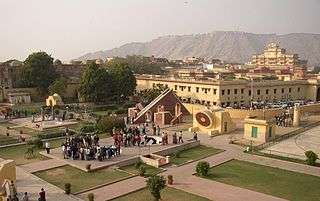
Soon after his defeat in 1527 at the Battle of Khanwa, Rana Sanga died in 1528. Bahadur Shah of Gujarat became a powerful Sultan. He captured Raiseen in 1532 and defeated Mewar in 1533. He helped Tatar Khan to capture Bayana, which was under Mughal occupation. Humayun sent Hindal and Askari to fight Tatar Khan. At the battle of Mandrail in 1534, Tatar Khan was defeated and killed. Puranmal, the Raja of Amber, helped the Mughals in this battle. He was killed in this battle. Now it became necessary for Humayun to crush the rising power of Bahadur Shah. While Bahadur Shah was besieging the fort of Chittorgarh, Humayun started against him. Hearing the news, the Rani Karnavati, widow of Rana Sanga, sent rakhi to Humayun. Humayun is considered to have accepted the rakhi, but stopped at Sarang Pur in January 1535. Mewar was weakened due to constant struggles. After a long wait, the Rajputs had the last fight on 8 March 1535, and Rani Karnavati, together with other women, committed Jauharthe same day. Humayun now pursued Bahadur Shah. Later Bahadur Shah and Sher Shah Suri created many problems for Humayun, and he lost the empire. He regained the empire in July 1555, and died in January 1556. Akbar, the son of Humayun, tried to persuade Mewar to accept Mughal sovereignty, like other Rajputs, but Rana Udai Singh refused. Ultimately Akbar besieged the fort of Chittor in 1567. This time, Rana Udai Singh left the fort with his family. Jaimal Rathore of Merta and Fatah Singh of Kelwa were left to take care of the fort. On 23 February 1568, Akbar hit Jaimal Rathore, who was looking after the repair work, with his gun. That same night, the Rajput women committed jauhar (ritual suicide) and the Rajput men, led by the wounded Jaimal and Fateh Singh, fought their last battle. Akbar entered the fort, and at least 30,000 people were killed. Later Akbar placed a statue of these two Rajput warriors on the gates of Agra Fort.[2]
Akbar and Rajputs
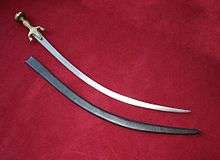
Akbar won the fort of Chittorgarh, but Rana Udai Singh was ruling Mewar from other places. On 3 March 1572 Udai Singh died, and his son, Maharana Pratap, sat on the throne at Gogunda. He vowed that he would liberate Mewar from the Mughals; until then he would not sleep on a bed, would not live in a palace, and would not have food on a plate (thali). Akbar tried to arrange a treaty with Rana Pratap, but did not succeed. Finally, he sent an army under Raja Man Singh in 1576. Rana Pratap was defeated at the Battle of Haldighati in June 1576. Rana Pratap escaped from the battle and started guerrilla warfare with the Mughals. Ultimately he was successful in liberating most of the Mewar, except the fort of Chittorgarh. The Bargujars were the main allies of the Ranas of Mewar. Rana Pratap died on 19 January 1597, and Rana Amar Singh succeeded him. Akbar sent Salim to attack Mewar in October 1603, but he stopped at Fatehpur Sikri and sought permission from the emperor to go to Allahabad, and went there. In 1605 Salim sat on the throne and took the name of Jahangir.[2]
Jahangir and Rajputs
Jahangir sent an army under his son Parviz to attack Mewar in 1606 which was defeated in the Battle of Dewar. The Mughal emperor sent Mahabat Khan in 1608. He was recalled in 1609, and Abdulla Khan was sent. Then Raja Basu was sent, and Mirza Ajij Koka was sent. No conclusive victory could be achieved. The disunity among various clans of Rajwada didn't allow Mewar to be completely liberated. Ultimately Jahangir himself arrived at Ajmer in 1613, and appointed Shazada Khurram to fight against Mewar. Khurram devastated the areas of Mewar and cut the supplies to the Rana. With the advice of his nobles and the crown prince, Karna, the Rana sent a peace delegation to Prince Khurram, Jahangir's son. Khurram sought approval of the treaty from his father at Ajmer. Jahangir issued an order authorising Khurram to agree to the treaty. The treaty was agreed between Rana Amar Singh and Prince Khurram in 1615.
- The Rana of Mewar accepted Mughal suzereignty.
- Mewar and the fort of Chittorgarh was returned to Rana.
- The fort of Chittorgarh could not be repaired or renovated by Rana.
- The Rana of Mewar would not attend the Mughal court personally. The crown prince of Mewar would attend the court and give himself and his army to the Mughals.
- There would be no matrimonial alliance of Mewar with the Mughals.
This treaty, considered respectable for both parties, ended the 88-year-long enmity between Mewar and the Mughals.[2]
Aurangzeb and Rajput rebellion
The Mughal emperor Aurangzeb (1658–1707), who was far less tolerant of Hinduism than his predecessors, placed a Muslim on the throne of Marwar when the childless Maharaja Jaswant Singh died. This enraged the Rathores, and when Ajit Singh, Jaswant Singh's son, was born after his death, the Marwar nobles asked Aurangzeb to place Ajit on the throne. Aurangzeb refused, and tried to have Ajit assassinated. Durgadas Rathore and the dhaa maa (wet nurse) of Ajit, Goora Dhaa (the Sainik Kshatriya Gehlot Rajputs of Mandore), and others smuggled Ajit out of Delhi to Jaipur, thus starting the thirty-year Rajput rebellion against Aurangzeb. This rebellion united the Rajput clans, and a triple-pronged alliance was formed by the states of Marwar, Mewar, and Jaipur. One of the conditions of this alliance was that the rulers of Jodhpur and Jaipur should regain the privilege of marriage with the ruling Sisodia dynasty of Mewar, on the understanding that the offspring of Sisodia princesses should succeed to the throne over any other offspring. Chhatrasal waged war against the Mughals and after leading a successful rebellion established his own kingdom which extende over most of the Bundelkhand.[1]:187–188
James Tod
James Tod, a British colonial official, was impressed by the military qualities of the Rajputs and their centuries-old struggle against invaders. In his Annals and Antiquities of Rajasthan, James Tod writes:[18]
What nation on earth could have maintained the semblance of civilization, the spirit or the customs of their forefathers, during so many centuries of overwhelming depression, but one of such singular character as the Rajpoot? ... Rajast'han exhibits the sole example in the history of mankind, of a people withstanding every outrage barbarity could inflict, or human nature sustain, from a foe whose religion commands annihilation; and bent to the earth, yet rising buoyant from the pressure, and making calamity a whetstone to courage .... Not an iota of their religion or customs have they lost.
References
- Sen, Sailendra (2013). A Textbook of Medieval Indian History. Primus Books. ISBN 978-9-38060-734-4.
- John Merci, Kim Smith; James Leuck (1922). "Muslim conquest and the Rajputs". The Medieval History of India pg 67-115
- Political History of the Chalukyas of Badami by Durga Prasad Dikshit p.166
- Panchānana Rāya (1939). A historical review of Hindu India: 300 B. C. to 1200 A. D. I. M. H. Press. p. 125.
- Kakar, Sudhir. The Colors of Violence: Cultural Identities, Religion, and Conflict. University of Chicago Press P 50. ISBN 0226422844.
- "Rajput". Encyclopædia Britannica. Retrieved 27 November 2010.
- R. C. Majumdar, ed. (1960). The History and Culture of the Indian People: The Delhi Sultante (2nd ed.). Bharatiya Vidya Bhavan. p. 70.
- Sastri, Hirananda (1931). Epigraphia Indica Vol.21. pp. 277–288.
- Sarda, Harbilas (March 2007). Maharana Kumbha: Sovereign, Soldier, Scholar. Read Books. p. 56. ISBN 978-1-4067-3264-1.
- Firishtah, Muḥammad Qāsim Hindū Shāh Astarābādī; Briggs, John (1997). History of the Rise of the Mahomedan Power in India: Till the Year A.D. 1612 Vol 4. Low Price Publications. pp. 81–83. ISBN 978-81-7536-077-8.
- Firishtah, Muḥammad Qāsim Hindū Shāh Astarābādī; Briggs, John (1997). History of the Rise of the Mahomedan Power in India: Till the Year A.D. 1612, Vol 4. Low Price Publications. pp. 262–63. ISBN 978-81-7536-077-8.
- Sarda, Har Bilas (1917). Maharana Kumbha: Sovereign, Soldier, Scholar. Scottish Mission Industries Company. p. 4.
- Sarda, Harbilas (March 2007). Maharana Kumbha: Sovereign, Soldier, Scholar. Read Books. p. 55. ISBN 978-1-4067-3264-1.
- Firishtah, Muḥammad Qāsim Hindū Shāh Astarābādī; Briggs, John (1997). History of the Rise of the Mahomedan Power in India: Till the Year A.D. 1612, Vol. 4. Low Price Publications. pp. 262–63. ISBN 978-81-7536-077-8.
- Sarda, Har Bilas (1917). Maharana Kumbha: Sovereign, Soldier, Scholar. Scottish Mission Industries Company. p. 56.
- Sarda, Har Bilas (1917). Maharana Kumbha: Sovereign, Soldier, Scholar. Scottish Mission Industries Company. p. 55.
- Dirk H. A. Kolff (8 August 2002). Naukar, Rajput, and Sepoy: The Ethnohistory of the Military Labour Market of Hindustan, 1450-1850. Cambridge University Press. pp. 60–62. ISBN 978-0-521-52305-9.
- Tod, James (1873). Annals and Antiquities of Rajast'han. Higginbotham & Co. p. 217.
What nation on earth could have maintained the semblance of civilization, the spirit or the customs of their forefathers, during so many centuries of overwhelming depression, but one of such singular character as the Rajpoot.
